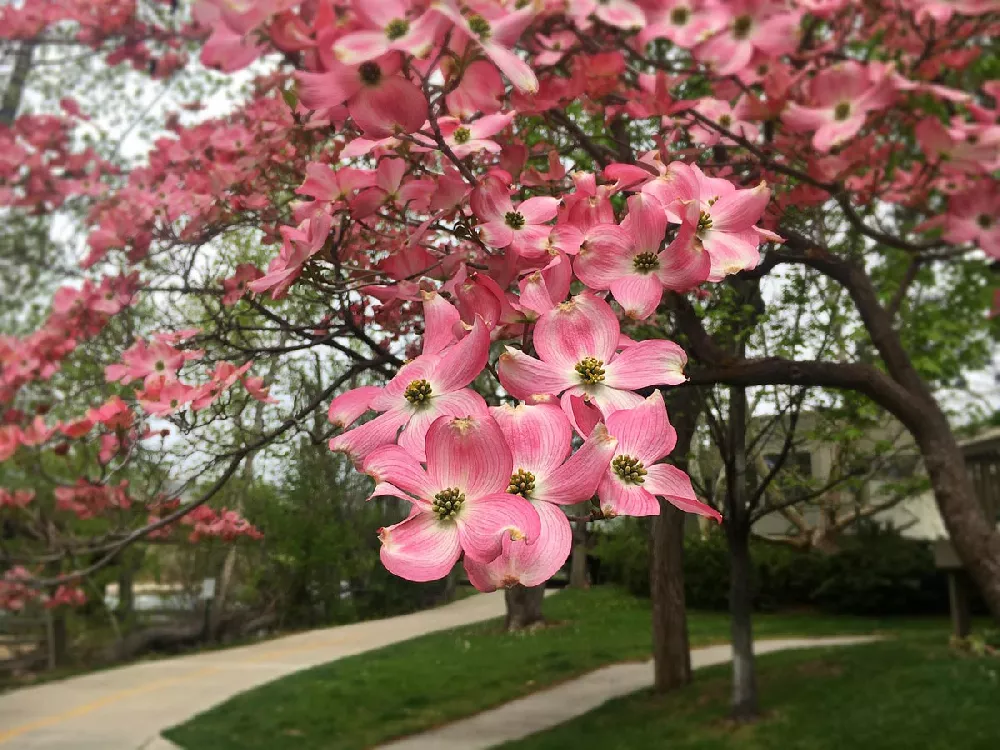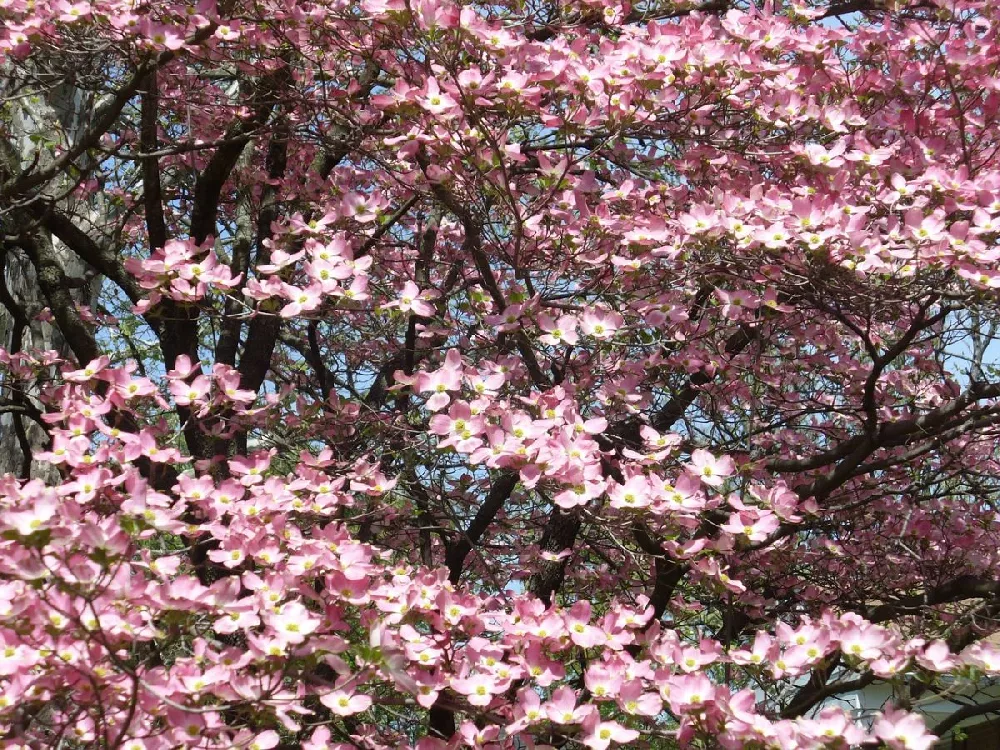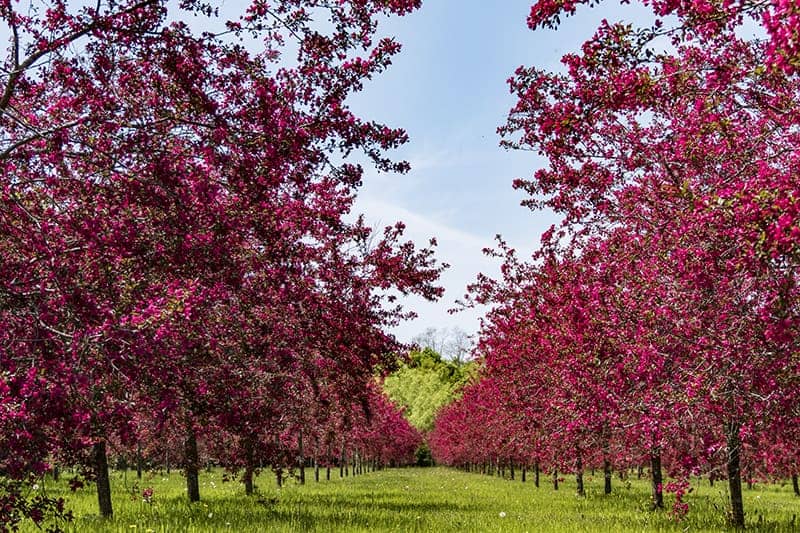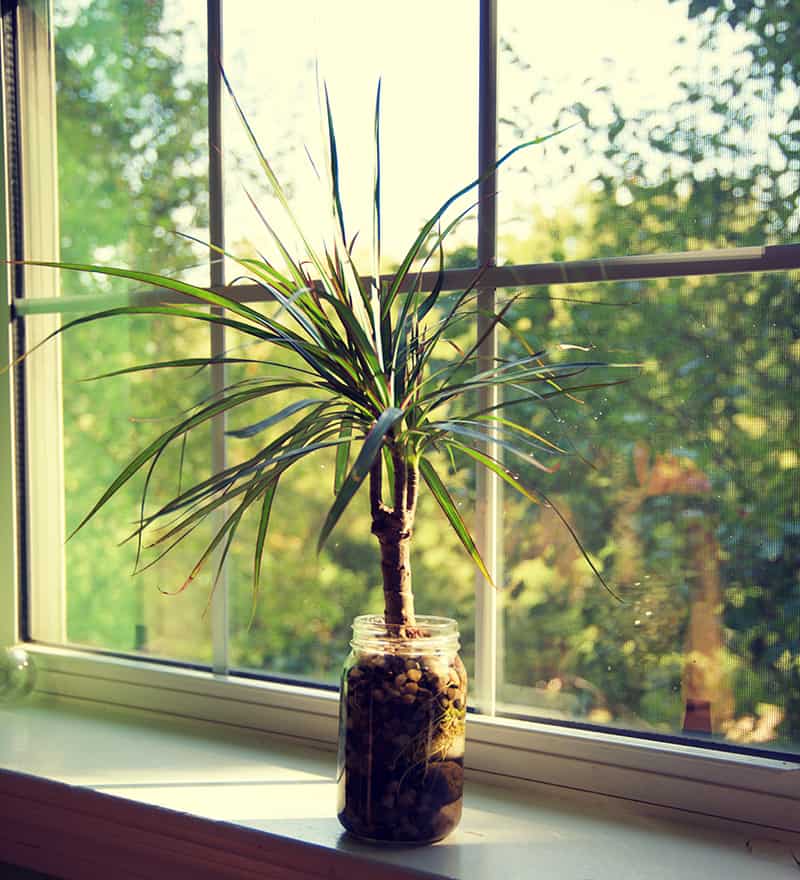- Home >
- Dogwood Trees
Dogwood Trees for Sale - Buying & Growing Guide
Filters
Price Range
Growing Zones
Plant Type
Flower Color
Sunlight
Mature Height
Plant Characteristics
20 Results
-
Growing Zone(s): 5-9$124.95
$199.95Save up to 37% -
Growing Zone(s): 5-9$99.95
$129.95Save up to 23% -
Growing Zone(s): 5-8$89.95
$93.95Save up to 4% -
Growing Zone(s): 5-9$74.95
$149.95Save up to 50% -
Growing Zone(s): 5-9$124.95
$149.95Save up to 16% -
Growing Zone(s): {"mgType":"string","mode":"source"}$25.95
-
Growing Zone(s): 5-8$78.95
$86.95Save up to 9% -
Sold OutGrowing Zone(s): 3-7$124.95
-
Sold OutGrowing Zone(s): 4-9$46.95
-
Sold OutGrowing Zone(s): 4-8$124.95
-
Sold OutGrowing Zone(s): 5-8$52.95
-
Sold OutGrowing Zone(s): 5-9$73.95
Dogwood Trees – Buying & Growing Guide
One of the most classic landscape trees, dogwoods add grace and presence to any yard they inhabit. Even better, they offer four seasons of beauty: showy pink or white flowers in the spring, a full canopy in the summer, fiery bright leaves in autumn, and, for some varieties, interesting bark patterns that light up the winter garden.
How to Grow Dogwood Trees
How to plant dogwood trees
Dogwood trees are best planted in late winter, after the ground has thawed but before buds have broken into new growth. Site your tree in well-drained, neutral-pH soil that is rich in organic matter. Your dogwood prefers partial shade, especially in the afternoon, and shelter from wind.
Dig a hole several times wider than your sapling’s root ball and just as deep. Mix a generous amount of compost, shredded leaves, or other organic material in the hole. If your soil is sandy, mix in peat moss or top soil to retain moisture. Loosen any roots that are circling the root ball so they don’t girdle the tree, and place your tree in the hole with the root ball extending several inches above ground level.
Backfill with soil, tamping as you go, and heap up the soil to cover the root ball. Water when the hole is halfway full, and again when you’re finished. If your site drains quickly, make a low ridge of soil around the trunk so the water can puddle there til it soaks down.
Add a mulch of chipped wood or pine straw around the trunk, and keep that area free of weeds, adding more mulch as necessary over the years.
How to achieve maximum results
Native to the eastern coast of the U.S., Dogwoods are understory trees, which means they naturally grow in a spot where they’re protected by other larger trees. You’ll achieve maximum results with these trees by planting them where they’ll be shielded from heavy winds and in partial shade. They make a great statement, for example, sited in front of mixed hardwoods.
How to Care for Dogwood Trees
Watering and nutrients
During its first few years, water your dogwood as necessary when rain is sparse. You want to keep the soil consistently moist, but not soggy, as dogwoods are susceptible to root rot. You can taper off watering the trees during the winter months, when they are dormant.
Apply a slow-release fertilizer formulated for landscape trees and shrubs in the early spring, before the tree breaks dormancy. Be stingy when applying the fertilizer – too much can burn the tree’s roots.
Pollination
What appears to be the flower of the dogwood is actually a series of four bracts, which surround the actual, tiny yellow flowers of the tree. They are not self-pollinating, and another tree, preferably of a different cultivar, is needed to produce the tree’s fruit, which ripens and falls to the ground in the fall.
Pruning
Dogwoods don’t require regular pruning. Remove dead or diseased branches, along with any that are crossed and rubbing against each other. Clip any suckers that form at the base of the trunk or branches that are too low and hard to mow under. The best time to prune is in summer, since they will bleed sap in the spring, which can be messy.
Pests, diseases, and animals
Anthracnose can infect dogwoods, leaving brown spots on leaves and dead tissue on leaf edges. Prune it out whenever it occurs, and remove leaf debris from around the base of the tree. Powdery mildew can also be a problem, but can be controlled with a fungicide or by planting mildew-resistant varieties such as the kousa dogwood.
The dogwood borer feeds beneath the bark of the dogwood, and can kill branches or even the tree itself. Monitor your tree for open wounds, and if you have a recurring problem with borers, apply permethrin to reduce infestations. Scale insects may be visible as small bumps on the bark, and can be killed with horticultural oil in the spring.
Deer may nibble on young dogwoods in the winter if food is scarce. Until your trees reach a decent size, you may want to burlap the trunks during the winter months.
Types of Dogwood Trees
1. Tatarian Dogwood

Scientific Name: Cornus alba
Mature Size: Up to 10 feet tall
USDA Hardiness Zone: 2-7
Light: Full sun to partial shade
Water: Average moisture needs
Soil: Well-draining
Flower Color: White
Cultivars and Varieties: Cornus alba ‘Sibirica’-Siberian Dogwood, Cornus alba ‘Kesselringii’-Black Stem Dogwood, Cornus alba ‘Elegantissima’-White Dogwood
This type of dogwood is highly ornamental, making a colorful display that changes with the seasons. It is native to Siberia, Korea and parts of China and can be grown as a small tree, or a medium to large shrub. In fall through to late winter, the stems of this deciduous plant are bare, but they are a feast for the eyes in bright shades of red. By late winter, the red stems are more vivid than most other types of dogwood. Flowers appear in late spring, in clusters filled with small cream-colored flowers that measure around two inches across. The flowers are not especially showy compared with the interesting foliage and stems of the tree, but they are attractive to butterflies and other pollinators. By mid-summer, the flowers will give way to dense clusters of berries that are usually white flushed with hints of blue.
These berries are a very popular source of food for birds. The foliage of the tree varies depending on variety, but leaves are usually ovate in solid bright green or variegated with a swirling mixture of green and cream. This tree has a vigorous growth habit and typically reaches around ten feet in height, though there are varieties that are much smaller or taller. The plant produces many suckers that allow it to spread to a wide shrub, but if grown as a tree, you will need to remove suckers as they appear and focus on one central stem to form the trunk of the tree. This is a hardy tree that is capable of withstanding very low temperatures and is ideal for growing in cold climates. It will grow in a variety of soil conditions, including wet soils, dry soils, and poor soils, though will perform best in a well-draining soil that is kept evenly moist. It can grow in full sun or partial shade but is not heat-tolerant. In warm summer climates, this plant is much more likely to fall victim to disease.
2. Evergreen Dogwood

Scientific Name: Cornus capitata
Mature Size: Up to 40 feet tall
USDA Hardiness Zone: 8-9
Light: Full sun to partial shade
Water: Maintain moist soil
Soil: Well-draining, organically rich
Flower Color: White
Cultivars and Varieties: Cornus capitata ‘Mountain Moon’
This tree is native to the Himilayan mountains and is also known by the common name of Himalayan dogwood. It has become naturalized in parts of Australia, including the states of Victoria and New South Wales. This is an evergreen plant that can be grown as a tree or large shrub. It has leathery leaves in a bright shade of green, which sometimes takes on a purple color in the fall. The undersides of the leaves have a furry texture.
In early summer, the plant produces tiny berry-like flowers that are surrounded by four white bracts. These bracts look like petals, and they are considered to be the flowers of the plant, although they do not technically fit this description. By fall, these flowers give way to red berries that look very similar to strawberries, measuring around one inch across. These berries are edible but are generally not considered very flavorsome and have a bitter taste. They are most popular among birds. These plants grow best in a sheltered position, in full sun to partial shade. They enjoy a well-draining soil that is organically rich. Maintain moist soil and avoid humid and very hot climates.
3. Flowering Dogwood

Scientific Name: Cornus florida
Mature Size: Up to 30 feet tall
USDA Hardiness Zone: 5-9
Light: Partial shade
Water: Maintain moist soil
Soil: Well-draining, fertile
Flower Color: White
Cultivars and Varieties: Cornus florida’ Cherokee Princess’, Cornus florida ‘Cloud Nine’, Cornus florida’ Cherokee Daybreak’
This deciduous plant can be grown as a small tree or large shrub. It is native to the eastern United States, growing from the Mississippi River across to Florida and up as far as Maine. The tree has a horizontal branching habit that gives it a flat canopy shape. In spring, flowers bloom along the bare branches before the arrival of foliage. The flowers are white, with five rounded bract ‘petals’ that spread out into a flat star shape. They bloom in great numbers, creating an impressive floral display. Each flower will typically measure around four inches across and then give way to dense clusters of glossy red berries in the summer.
The berries can last right through to winter on the tree unless they are feasted on by birds. The foliage of this dogwood arrives in a medium shade of bright green and deepens to a dark green as it matures. By fall, the leaves develop to rich shades of purple and red before dropping from the tree. Once the tree is bare and all of the flowers, berries, and foliage have disappeared, it still retains interest with its patterned bark. The gray bark has a crocodile skin pattern on it, which becomes more pronounced as the tree ages. Grow this tree in a well-draining soil that is kept moist. It thrives in partial sun, and though it can tolerate a position of full sun, it will become dense and more prone to disease.
4. Kousa Dogwood

Scientific Name: Cornus kousa
Mature Size: Up to 35 feet tall
USDA Hardiness Zone: 5-8
Light: Full sun to partial shade
Water: Average moisture needs
Soil: Well-draining, fertile
Flower Color: White
Cultivars and Varieties: Cornus kousa ‘Miss Satomi’, Cornus kousa’ China Girl’, Cornus kousa’ White Fountain’
This tree is native to parts of Asia, including China and Japan, and is accordingly also known as Chinese dogwood and Japanese dogwood. It has also become naturalized in the state of New York. It is a deciduous plant that is most commonly grown as a small tree but can also be grown as a multi-stemmed shrub. Aesthetically, this tree looks very similar to the flowering dogwood (Cornus florida) but can be distinguished by its branches that have a more upright habit. This tree also blooms about a month later than the flowering dogwood, and its petal-like bract that forms the flowers have more pointed tips, as opposed to the flowering dogwood that has rounded bracts.
The blooms give way to berries in summer, which are pink-red and round in shape. They typically measure around an inch across and are edible. They have a sweet flavor and are sometimes used to produce wine. They are also popular with birds, though any berries that do not get eaten will remain on the tree right through to winter, adding a nice color contrast against the fresh green foliage. In fall, the leaves fade to deep shades of red and purple before dropping to the ground. Even in winter, this bare tree is interesting to look at, with an attractively shaped skeleton and mottled gray-brown bark.
This tree is known for being more disease-resistant and hardier than the flowering dogwood, so it may be a good alternative to this plant if you live in a cooler region. It thrives in a well-draining soil that is kept evenly moist, though it does have some tolerance of drought once established. It performs well in both full sun and partial shade.
5. Wedding Cake Dogwood

Scientific Name: Cornus controversa
Mature Size: Up to 50 feet tall
USDA Hardiness Zone: 6-9
Light: Full sun to partial shade
Water: Average water needs
Soil: Well-draining, organically rich
Flower Color: White
Cultivars and Varieties: Cornus controversa’ Variegata’, Cornus controversa ‘Pagoda’
This is a small to medium-sized deciduous tree that is native to Asia. It is commonly known as the wedding cake dogwood because of the way its horizontal branches are layered on top of each other to resemble the look of a tiered wedding cake. The most popular example of this tree is the ‘Variegata’ cultivar, which has green leaves with creamy white margins. This type of wedding cake dogwood tree is also typically around ten to twenty feet smaller than the standard wedding cake dogwood. The foliage of these trees is ovate, and each leaf can measure between three and six inches long. They are ordinarily dark green but fade to yellow-orange in the fall before dropping.
The tree blooms in late spring, with flattened panicles of small white flowers clustered together. These give way to black colored berries in late summer, which are popular among birds. This tree makes a beautiful specimen tree and also works well in parks and public areas to provide shade, as its canopy grows to be as wide as it is tall. It can thrive in full sun, though in hot summer climates, it prefers shade in the afternoons. Grow this plant in a well-draining soil that is rich in organic content and kept consistently moist.
6. Cornelian Cherry Dogwood

Scientific Name: Cornus mas
Mature Size: Up to 40 feet tall
USDA Hardiness Zone: 5-8
Light: Full sun to partial shade
Water: Average moisture needs
Soil: Well-draining
Flower Color: Yellow
Cultivars and Varieties: Cornus mas’ Early Yellow’, Cornus mas ‘Gourmet’, Cornus mas ‘Jolico’
This deciduous plant is native to Southwest Asia and Southern Europe. It can be grown as a small to medium tree or a large shrub. It provides all year interest in spite of being deciduous. In spring, the tree blooms with showy clusters of tiny yellow flowers that arrive on the bare branches. These last for several weeks before the arrival of the leaves, which are deep green and oval-shaped. In fall, the foliage develops to a dark purple before being shed.
Berries form on the tree in midsummer, which are a glossy cherry-like fruit in a bright shade of red. These berries are edible and resemble the taste of cherries and cranberries. They are widely used throughout Europe and some parts of Canada to make sauces and jams, drinks and can also be eaten dry. In winter, the naked tree also maintains interest with its rich brown exfoliating bark. This is a low maintenance tree that is easy to grow and has good resistance to pests and disease. It has won several awards for its outstanding qualities. It can be grown in full sun or partial shade and thrives in moist, well-draining soils.
7. Pacific Dogwood

Scientific Name: Cornus nuttallii
Mature Size: Up to 80 feet tall
USDA Hardiness Zone: 5-9
Light: Full sun to partial shade
Water: Maintain moist soil
Soil: Well-draining, fertile
Flower Color: White and yellow
Cultivars and Varieties: Cornus nuttallii ‘Goldspot’
This deciduous tree is native to western North America, from British Columbia in Canada down to California in the United States. It is small to medium in size, with a mature height ranging from 30 to 80 feet. The oval foliage of the tree is dark green, and typically each leaf measures around four inches long. In fall, the foliage develops into attractive shades of red and purple. The blooms consist of a cluster of tiny flowers that are surrounded by large white bracts that mimic the look of petals.
The flower of this tree has been British Columbia’s provincial flower since 1956, and a law was imposed to protect the species in this province, though it was revoked in 2002. The flowers give way to clusters of pink-red berries. These fruits are edible though they are not considered to be very tasty and are usually only consumed by birds. This tree grows best in well-draining soil that is kept consistently moist.















